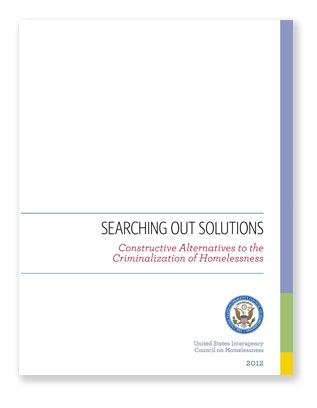Alternatives to Criminalization
Searching out Solutions: Constructive Alternatives to the Criminalization of Homelessness
Individuals and families experiencing street homelessness face many barriers on their path to stability. Over and above their housing, physical, and behavioral health needs, many communities implement local measures that criminalize “acts of living” laws that prohibit sleeping, eating, sitting, or panhandling in public spaces, acts which generally are applicable to people who do not have a permanent place to call home, and by their very nature criminalize homelessness. Communities implement these measures as a way to broadcast a zero-tolerance approach to street homelessness and to attempt to reduce the visible signs of homelessness.
Criminalization policies, however, are not a solution to the problem of homelessness and are often costly and consume substantial state and local resources. In today’s economic climate, it is important for state, county, and local entities to invest in programs that work rather than spend money on activities that are unlikely to achieve the desired result. It is better for the individuals who are homeless and for the community if policies and programs are implemented with the goal of safely housing and stabilizing vulnerable individuals and families.
USICH and the Access to Justice Initiative of the U.S. Department of Justice, with support from the Department of Housing and Urban Development, convened a summit on the development of constructive alternatives to the criminalization of homelessness. This summit produced information on effective and promising practices that serve as alternatives to criminalization and are improving the lives of individuals experiencing homelessness and the community as a whole.
USICH has documented these practices and policies in “Searching out Solutions: Constructive Alternatives to the Criminalization of Homelessness” (SOS). The practices and policies identified in SOS and in the following articles have been effective in reducing and preventing homelessness in several communities around the country.
SOS identifies three solutions, examples of specific strategies and interventions, and their successful implementation in communities across the country.
- The creation of comprehensive and seamless systems of care. In an effort to address gaps in service delivery, many local organizations partner with other service providers and government programs to combine housing and services that are supported by communitywide planning. These systems of care enable long-term reductions in street homelessness and connect individuals with benefits and services that improve stability.
- Collaboration between law enforcement and behavioral health and social service providers. Collaboration between service providers and law enforcement regarding outreach to individuals and specialized crisis intervention training can limit the number of arrests for non-violent offenses. This partnership can also help link individuals experiencing street homelessness with supportive housing and services to help individuals move off the street permanently.
- Alternative justice system strategies. Strategies that provide alternatives to prosecution and incarceration and that offer reentry planning for individuals who are returning to the community after interaction with the criminal justice system, have shown an increase in the likelihood that an individual experiencing homelessness will look for permanent housing and seek employment. This solution includes use of specialty courts, citation dismissal programs, holistic public defenders offices, and reentry programs.
Implementing alternatives to the criminalization of homelessness can adequately balance the rights and needs of all those affected by street homelessness in order to achieve the goal of ending it. Community residents, government agencies, businesses, and men and women who are experiencing homelessness are better served by solutions that do not marginalize people experiencing homelessness, but rather strike at the core factors contributing to homelessness. Successful alternatives are focused on working with people experiencing homelessness to help them overcome barriers to housing and are grounded in community engagement. Whether engaged as outreach workers, volunteers, funders, or professional support, when the larger community is informed and working together with mainstream and justice providers, alternatives to criminalization have shown positive results.
Each solution outlined in SOS has community engagement as a centerpiece of the effort to impact homelessness. Whether engaged as outreach workers, volunteers, funders, or professional support, when the larger community is informed and working together with mainstream and justice providers alternatives to criminalization have shown positive results.
Together, we are making strides in our efforts to end homelessness, and to build our momentum we must enact solutions that get individuals off the streets into a safe and stable home. USICH asks communities to review the solutions in SOS and find ways to implement them in your cities and towns. In addition, strengthen partnerships among community-based organizations, local government, law enforcement, private business, and volunteers to keep the work of ending homelessness focused on getting individuals into safe, affordable housing and ensuring that the needed stabilizing services are available and easily accessed. Finally, communicate with us to let us know when your community is implementing creative and effective alternatives that end homelessness and save lives.
The articles linked below provide detailed information on all three of the alternatives encouraged in Searching Out Solutions.
Housing, Services and Partnerships: a Successful Combination to End Street Homelessness
USICH spoke with Bill Hobson, the Executive Director of DESC in Seattle about the development of a seamless system of care
Justice System Alternatives
USICH highlights three alternative justice system strategies that are especially successful at minimizing the negative effects of criminal records and connecting individuals experiencing homelessness with needed service: the development of holistic public defenders offices, the use of problem-solving courts, and comprehensive reentry services. USICH interviewed Jeanette Kinard, Director of the Mental Health Public Defenders Office in Travis County, Texas and Steve Binder, the Deputy Public Defender in San Diego and the co-founder of the Homeless Court Program of San Diego.
Blog
What We're Talking About: The Week at USICH - October 1-4
Collaborating for Reentry Success: Returning Home Ohio
Ending the Cycle between Corrections and Homelessness
Endorsing Solutions to the Criminalization of Homelessness – Mayors Taking the Lead
A PHP Error was encountered
Severity: Notice
Message: Undefined index: 1510
Filename: libraries/Functions.php(650) : eval()'d code
Line Number: 354
USICH Webpages
Successful Reentry Program: Oakland Prisoner Reentry Initiative
The Oakland Prisoner Reentry Initiative (OPRI) Program is a two-year-old collaborative (or “the collaborative) among the Oakland ...
Successful Reentry Program: The Fortune Society
The New York City Department of Corrections (DOC) admitted 87, 515 people into the city’s jail system during FY2011. 77.7% of ...
Federal Efforts to Improve Reentry: Federal Interagency Council on Reentry
For those leaving incarceration, overcoming the barriers to successful reentry may mean the difference between living a healthy and ...
Reentry In Focus
October 2012 Annually, approximately 730,000 Federal and state prisoners return to communities and over 9 million pass through local ...




































